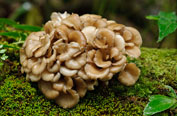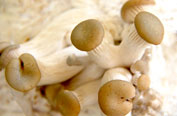

Allgemeines
-
Coprinus comatus
Synonyme: Schopftintling, Porzellantintling, Tintenpilz, Tintenschopfling, SpargelpilzInhaltsstoffe: u.a. Polysaccharide (Fucogalactan), Lektine, L-Ergothionin
Traditionelle Anwendungsgebiete:
- Sarkome (1)
- Begleitend zur Therapie bei hormonabhängigen Tumoren (2)
- Diabetes (3-5)
- Begleitend zur Therapie bei Brustkrebs (6)
Coprinus comatus bewirkt erwiesenermaßen eine erhöhte Insulinausschüttung bzw. Blutzuckersenkung bei Diabetes 1 und 2, ohne die bei gängigen Medikamenten üblichen Nebenwirkungen (sh. Coprinus comatus (3 - 5)).
2001 veröffentlichte Untersuchungsergebnisse attestieren dem Coprinus comatus eine potentiell krebshemmende (Brustkrebs) Wirkung (sh. Coprinus comatus (6)).
Chinesische Wissenschaftler wiesen 2013 in Experimenten mit aus Coprinus comatus gewonnenen Stoffen eine Hemmung des Wachstums von bösartigen Geschwülsten des Binde- und Stützgewebes nach (sh. Coprinus comatus (1)).
Über den Pilz:
Verbreitung und Habitat in der Natur:
An Wegrändern, in Parks und Wiesen. In der gesamten nördlichen Hemisphäre verbreitet.Verwendung:
Speisepilz, VitalpilzCoprinus enthält eine ausgewogene Vitamin- und Mineralstoffzusammensetzung und stellt damit einen wichtigen Beitrag zur täglichen ausgewogenen Ernährung dar. Von therapeutischem Interesse sind der hohe Gehalt an Lektinen sowie das enthaltene L-Ergothionein. Als potentielle Wirkstruktur konnte vor kurzem in Coprinus comatus das Polysaccharid Fucogalactan identifiziert werden.
Studien
-
Wissenschaftliche Studien über Coprinus comatus
1) Int J Biol Macromol. 2013 Jul;58:349-53. doi: 10.1016/j.ijbiomac.2013.04.033. Epub 2013 Apr 18. Antitumor and immunomodulatory activity of a polysaccharide from fungus Coprinus comatus (Mull.:Fr.) Gray. Jiang XG, Lian MX, Han Y, Lv SM.2) Zaidman BZ, Wasser SP, Nevo E, Mahajna J: Coprinus comatus and Ganoderma lucidum interfere with androgen receptor function in LNCaP prostate cancer cells. Mol Biol Rep. 2007 Mar 13; [Epub ahead of print]
3) Han C, Yuan J, Wang Y, Li L: Hypoglycemic activity of fermented mushroom of Coprinus comatus rich in vanadium. J Trace Elem Med Biol. 2006;20(3):191-6
4) C. J. Bailey, Susan L. Turner, K. J. Jakeman, W. A. Hayes: Effect of Coprinus comatus on plasma glucose concentrations in mice. Planta Med 1984; 50: 525-526
5) Wang F, Ding ZY, Zhang KC: Inhibitory Effects of fermented broth of coprinus comatus feeding with different traditional Chinese medicines on alpha- glucosidase and non-enzymatic glycosylation. Chinese Journal of Pharmaceuticals 2006;37(6):384-7
6) The Shaggy Inc Cap Medicinal Mushroom, Coprinus comatus (O.F.Mull.:Fr.) Pers. (Agaricomycetideae) Substances Interfere with H2O2 Induction of NF-κB Pathway through Inhibition of IκBα Phosphorylation in MCF7 Breast Cancer Cells 19 Mikheil D. Asatiani, Solomon P. Wasser, Eviatar Nevo, Nili Ruimi, Jamal Mahajna & Abraham Z. Reznick INTERNATIONAL JOURNAL OF MEDICINAL MUSHROOMS Vol. 13, Issue 1
Taxonomie
-
Taxonomie:
Klasse: Agaricomycetes
Unterklasse: Agaricomycetidae
Ordnung: Champignonartige (Agaricales)
Familie: Tintlingsverwandte (Coprinaceae)
Gattung: Tintlinge (Coprinus)
Sporen: Schwarz, 11 - 15 x 6,0 - 8,5 µ Zuchtbedingungen
-
Zuchtbedingungen
Phase 1: Mycelwachstum
Temperatur: 21 - 27°C
Luftfeuchte: 95 - 100%
Dauer: 12 - 14 Tage
CO2: 5,000 - 20,000 ppm
Raumluftwechsel: 0 - 1 pro Stunde
Licht: n/a
Phase 2: Aufstellen der Myzelien / Einleitung der Fruchtung
Temperatur: 16 - 21°C
Luftfeuchte: 95 - 100%
Dauer: 12 - 15 Tage nach dem abdecken
CO2: 500 - 1,000 ppm
Raumluftwechsel: 4-8 pro Stunde
Licht: 500 - 1,000 Lux für 8 Stunden pro Tag
Phase: Fruchtung und Ernte
Temperatur: 18 - 24°C
Luftfeuchte: 80 - 90%
Dauer: 5 - 7 Tage
CO2: 500 - 1,000 ppm
Raumluftwechsel: 4 - 8 pro Stunde
Licht: 500 - 1,000 Lux für 8 Stunden pro Tag
Erntewellen: 2 - 3 Ernten alle 4 bis 10 Tage
Geeignetes Substrat:
Pilzzuchtkompost


















